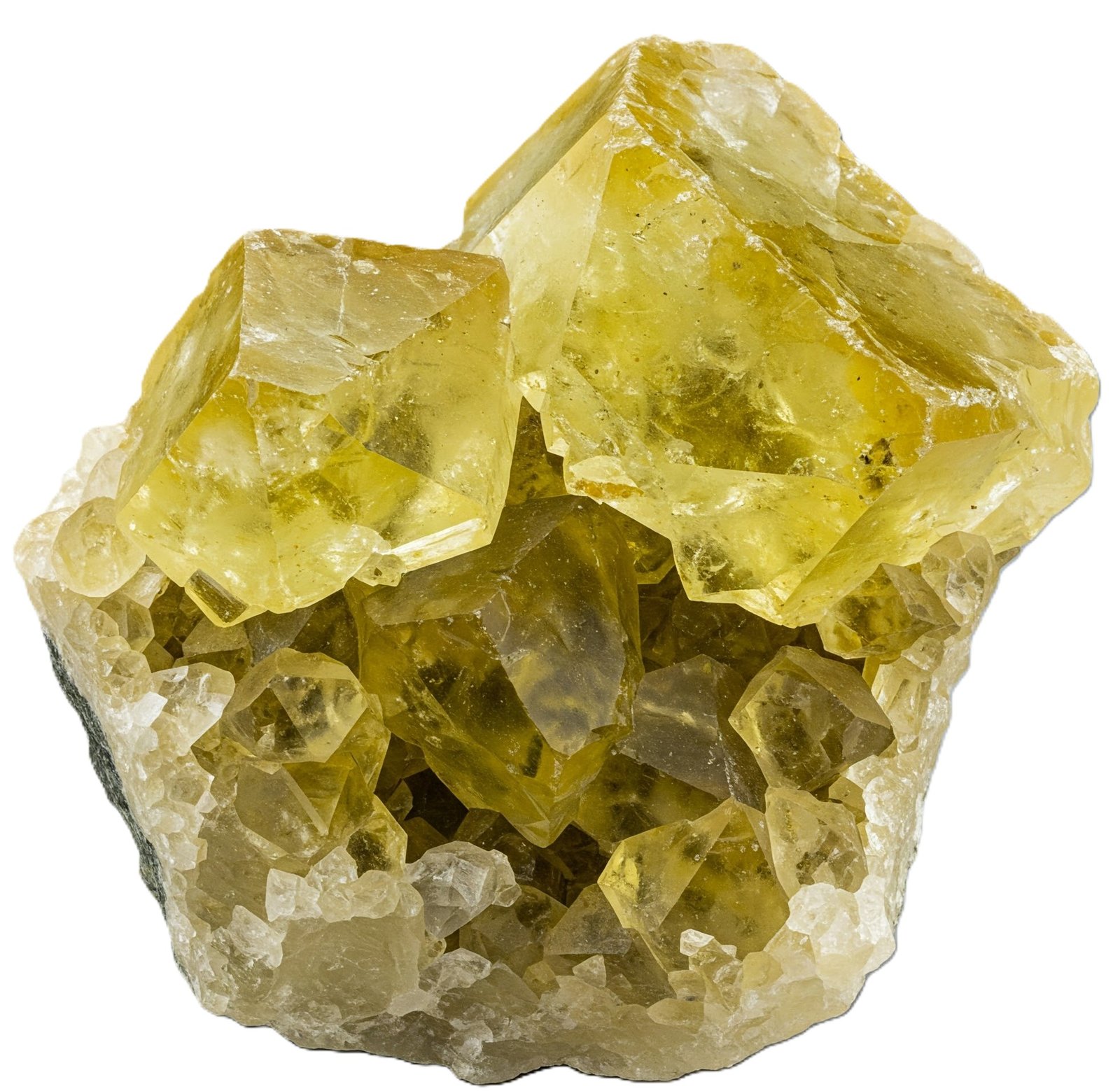
The name “fluorite” is derived from the Latin word fluo, meaning “to flow,” due to the mineral’s characteristic ability to melt easily when heated. The specific reference to yellow fluorite is in relation to its distinct yellow colour, which can vary from a pale, almost translucent yellow to a deeper, more golden shade. Fluorite itself was first described in the 16th century, but yellow fluorite as a unique form became widely recognised in the 18th and 19th centuries when it was differentiated from other varieties of the mineral.
Composition and Structure
Fluorite, also known as calcium fluoride (CaF2), is a mineral composed primarily of calcium and fluorine. Yellow fluorite, like other varieties of fluorite, belongs to the halide group of minerals and forms in cubic crystals, though it can also occur as octahedrons. The colour of fluorite is caused by various impurities and trace elements in the crystal’s structure. In the case of yellow fluorite, it is believed that trace amounts of iron or other elements can impart the brilliant yellow hue.
The mineral’s structure is highly symmetrical, which is one of the reasons it is favoured both by mineral collectors and those who use it in various healing practices. It is an abundant and soft mineral (4 on the Mohs scale of hardness), which makes it easy to shape and cut into various forms, including jewellery and ornamental objects.
Locations and Geological Distribution
Yellow fluorite can be found in numerous locations across the globe. Some of the most significant deposits are in the United States, specifically in states such as Illinois and Kentucky, where fluorite mining has a long history. Other notable sources include Mexico, China, and the United Kingdom. The mineral forms in hydrothermal veins, often in association with other minerals such as calcite, quartz, and barite.
One of the most famous fluorite mining areas is the “Fluorspar District” in the United States, known for its rich deposits of fluorite in a variety of colours, including yellow. These deposits have not only been a source of industrial fluorite but also a source of fascination for collectors due to the beauty and diversity of the mineral specimens found there.
Archaeological Finds and Historical Records of Use
Fluorite’s history of use dates back thousands of years. While yellow fluorite might not have been as prominent in ancient civilisations as other forms of the mineral, historical records show that fluorite was recognised and valued for its beauty and utility.
In ancient China, fluorite was carved into ornaments. It was believed to hold protective qualities and was used in traditional medicine, albeit less commonly than other gemstones. Similarly, in the Roman Empire, fluorite was occasionally used for ornamental carvings.
Fluorite’s most notable historical use was in the production of hydrofluoric acid, a byproduct of fluorite processing that has had applications in metallurgy, glassmaking, and chemistry. However, the more esoteric uses of yellow fluorite, such as in healing and spiritual practices, did not emerge until much later, particularly in the modern era.
Folklore, Legends, and Tales
Yellow fluorite has been the subject of many myths and legends throughout history. In some cultures, fluorite, especially the yellow variety, was thought to hold the power to ward off evil spirits and protect its wearer from negative energy. It was often carried as a talisman by travellers and warriors who believed it could provide clarity of mind and guidance in challenging situations.
In medieval Europe, there were tales of “fluors,” which were mystical stones believed to possess the ability to influence the mind and body. Some legends even suggested that yellow fluorite could enhance intelligence, intuition, and creativity, as the color itself was associated with the sun, intellect, and enlightenment.
In other stories, yellow fluorite was said to be a stone of transformation. It was believed that wearing the gem could help a person gain insight into their true purpose in life, providing the mental clarity necessary to overcome obstacles and achieve success.
Links with Astrology and the Chakra System
Yellow fluorite has strong associations with both astrology and the chakra system. In astrology, yellow fluorite is often linked to the signs of Leo and Gemini. Leo, ruled by the sun, shares the solar connection of yellow fluorite, which is often regarded as a stone that enhances the strength of the mind and spirit. For Gemini, known for its adaptability and intelligence, yellow fluorite is believed to bring balance, harmony, and insight, allowing for clearer communication and better decision-making.
In the chakra system, yellow fluorite is most connected with the Solar Plexus Chakra, which is in the upper abdomen and governs personal power, self-esteem, and mental clarity. The yellow colour of the stone resonates strongly with this chakra, helping to activate and balance it. When the Solar Plexus Chakra is in balance, it is said that an individual experiences a greater sense of confidence, clarity of thought, and the ability to take decisive action.
Yellow fluorite is also thought to support the Crown Chakra, located at the top of the head. This chakra is associated with spiritual awareness and connection to higher realms. Yellow fluorite is believed to open communication with the spiritual realm, helping individuals tap into their intuition and expand their consciousness.
